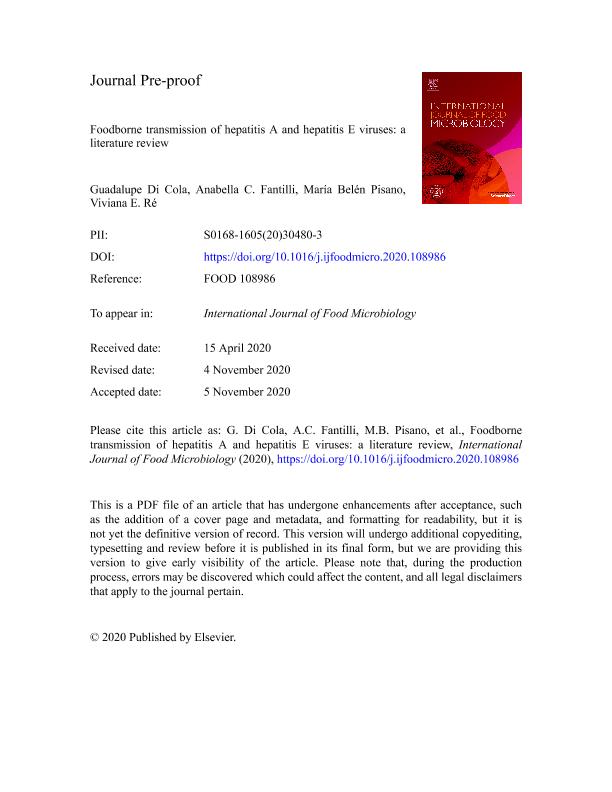Artículo
Foodborne transmission of hepatitis A and hepatitis E viruses: A literature review
Di Cola Bucciarelli, Guadalupe ; Fantilli, Anabella Clara
; Fantilli, Anabella Clara ; Pisano, María Belén
; Pisano, María Belén ; Ré, Viviana Elizabeth
; Ré, Viviana Elizabeth
 ; Fantilli, Anabella Clara
; Fantilli, Anabella Clara ; Pisano, María Belén
; Pisano, María Belén ; Ré, Viviana Elizabeth
; Ré, Viviana Elizabeth
Fecha de publicación:
02/01/2021
Editorial:
Elsevier Science
Revista:
International Journal of Food Microbiology
ISSN:
0168-1605
e-ISSN:
1879-3460
Idioma:
Inglés
Tipo de recurso:
Artículo publicado
Clasificación temática:
Resumen
Foodborne viruses have been recognized as a growing concern to the food industry and a serious public health problem. Hepatitis A virus (HAV) is responsible for the majority of viral outbreaks of food origin worldwide, while hepatitis E virus (HEV) has also been gaining prominence as a foodborne viral agent in the last years, due to its zoonotic transmission through the consumption of uncooked or undercooked infected meat or derivatives. However, there is a lack of scientific reports that gather all the updated information about HAV and HEV as foodborne viruses. A search of all scientific articles about HAV and HEV in food until March 2020 was carried out, using the keywords “HAV”, “HEV”, “foodborne”, “outbreak” and “detection in food”. Foodborne outbreaks due to HAV have been reported since 1956, mainly in the USA, and in Europe in recent years, where the number of outbreaks has been increasing throughout time, and nowadays it has become the continent with the highest foodborne HAV outbreak report. Investigation and detection of HAV in food is more recent, and the first detections were performed in the 1990s decade, most of them carried out on seafood, first, and frozen food, later. On the other hand, HEV has been mainly looked for and detected in food derived from reservoir animals, such as meat, sausages and pate of pigs and wild boars. For this virus, only isolated cases and small outbreaks of foodborne transmission have been recorded, most of them in industrialized countries, due to HEV genotype 3 or 4. Virus detection in food matrices requires special processing of the food matrix, followed by RNA detection by molecular techniques. For HAV, a real-time PCR has been agreed as the standard method for virus detection in food; in the case of HEV, a consensus assay for its detection in food has not been reached yet. Our investigation shows that there is still little data about HAV and HEV prevalence and frequency of contamination in food, prevalent viral strains, and sources of contamination, mainly in developing countries, where there is no research and legislation in this regard. Studies on these issues are needed to get a better understanding of foodborne viruses, their maintenance and their potential to cause diseases.
Palabras clave:
DETECTION IN FOOD
,
FOOD
,
FOODBORNE OUTBREAK
,
FOODBORNE VIRUSES
Archivos asociados
Licencia
Identificadores
Colecciones
Articulos(CCT - CORDOBA)
Articulos de CTRO.CIENTIFICO TECNOL.CONICET - CORDOBA
Articulos de CTRO.CIENTIFICO TECNOL.CONICET - CORDOBA
Citación
Di Cola Bucciarelli, Guadalupe; Fantilli, Anabella Clara; Pisano, María Belén; Ré, Viviana Elizabeth; Foodborne transmission of hepatitis A and hepatitis E viruses: A literature review; Elsevier Science; International Journal of Food Microbiology; 338; 2-1-2021; 1-60
Compartir
Altmétricas



